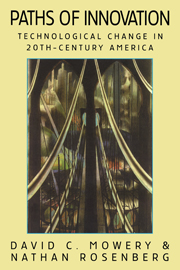6 - The Electronics Revolution, 1947–90
Published online by Cambridge University Press: 05 June 2012
Summary
Like most of the major technological advances considered in this volume, electricity and its associated innovations were complex systems of technologies, advances that frequently relied heavily on incremental improvements in individual components. Its complex and “systemic” nature meant that both adoption and realization of the productivity-enhancing effects of electrification took considerable time. An important characteristic of the evolution of electrical technologies, as well as chemicals and the internal combustion engine, is the frequent appearance of “technology bottlenecks,” often centered around individual components or the interconnections of components, within the system. Such bottlenecks also launched and guided the evolution of electronics technologies. The emergence of a critical bottleneck in telecommunications, as we note in this chapter, motivated Bell Telephone Laboratories to undertake the research program that produced the first transistors and ultimately launched the postwar electronics revolution. The subsequent development of electronics components and the computer systems into which they are incorporated has been influenced by the enduring need to resolve obstacles to further progress that are imposed by other elements of these complex systems – examples include excessive numbers of discrete components, complex software, and a lack of interchangeability in components.
Advances in electronics technology created three new industries – electronic computers, computer software, and semiconductor components – in the postwar U.S. economy. Electronics-based innovations supported the growth of new firms in these industries and revolutionized the operations and technologies of more mature industries, such as telecommunications, banking, and airline and railway transportation.
- Type
- Chapter
- Information
- Paths of InnovationTechnological Change in 20th-Century America, pp. 123 - 166Publisher: Cambridge University PressPrint publication year: 1998
- 1
- Cited by

